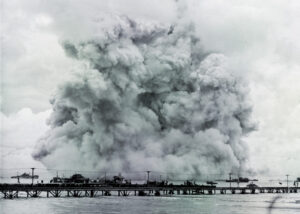The Last Shot: The Incredible Story of the C.S.S. Shenandoah and the True Conclusion of the American Civil War
by Lynn Schooler, HarperCollins Publishers, 2005, 320 pages, $24.95.
Sea of Gray: The Around-the-World Odyssey of the Confederate Raider Shenandoah
by Tom Chaffin, Hill and Wang, 2006, 448 pages, $25.
The Voyage of the CSS Shenandoah: A Memorable Cruise
by William C. Whittle Jr., The University of Alabama Press, 2005, 312 pages, $45.
The naval side of the American Civil War has always been the poor relation to the epic land clashes between the Army of the Potomac and the Army of Northern Virginia, yet it produced more than its share of technical innovations (the first use of mines, ironclad rams and the first sinking of a warship by a submarine) and drama on a global scale. While the war’s overall social and political effects were profound, the sea war arguably did the most lasting physical damage—between ships sunk, captured and sold to foreign flags to avoid those fates, the U.S. Merchant Marine did not recover from the depredations of a handful of Confederate cruisers (i.e., commerce raiders) until 1940. The British-built CSS Alabama still holds the world record for ships sunk or captured by a single raider.
Second to Alabama in damage done was CSS Shenandoah, which also holds the dubious distinction of firing the last shot on behalf of a Confederacy that, unknown to its crew at the time, no longer existed. Its officer and mostly foreign-born volunteer crew were also the last Rebels to strike the Confederate colors when it put into Liverpool, England, on November 6, 1865. By then, the former British troopship Sea King had sailed 58,000 miles in 13 months, through every ocean except the Antarctic, capturing 38 merchant or whaling ships, of which six were bonded and 32 destroyed, representing an overall value of $1,172,223.
While its story has been told before, Shenandoah’s remarkable odyssey in the face of daunting odds—starting with putting out to sea with an almost hopelessly understrength crew, which would be filled out later—gets a reasonable retelling by Lynn Schooler in The Last Shot. Where this saga differs from its predecessors is that the Alaskan author began his research after discovering that Shenandoah, in ravaging a fleet of Yankee whalers in the Sea of Okhotsk in June 1865, had brought his state (though it wouldn’t achieve that status until almost 100 years later) into the war.
As with many labors of love written by Civil War authors of a given state, The Last Shot shows the enthusiasm and wonder that went into its writing. This helps place readers unfamiliar with the story right at the stern of the roving sea raider, and gives buffs a fresh feel for the subject—enough, perhaps, for all but Georgian and Virginian readers to forgive the author’s one offhand reference to Maj. Gen. William T. Sherman’s swath of destruction through the Shenandoah Valley in the late fall of 1864. Aside from that brief though not insignificant gaffe, The Last Shot gives a reasonably balanced outsider’s view of a unique adventure among the many that occurred during the Civil War at sea.
Unfortunately for Schooler, the publication of his book coincides with that of two others. Drawing in equal degree from the extensive memoirs left behind by Shenandoah’s officers, Sea of Gray tells the same tale just as well, but additionally provides Civil War scholars with more of the background and context behind the Confederate raiding program in general, and Shenandoah in particular.
For example, before describing Lt. Cmdr. James I. Waddell’s unique voyage, author Tom Chaffin reveals that the Confederate Navy’s resourceful chief, Stephen Mallory, was initially hesitant to resort to commerce raiding, since Britain, France, Prussia, Austria, Turkey and Russia had signed a treaty renouncing privateering in 1856. Only when hopes of recognition by the European powers waned and the Union blockade of Southern ports tightened did Mallory authorize his agents abroad, most notably James D. Bulloch in England, to pursue the clandestine purchase and commissioning of cruisers, ironically causing the United States to reap what it had sown because of its failure to sign the 1856 treaty. Overall, Sea of Gray provides a more comprehensive combination of “big picture” and on-board “little picture” of Shenandoah’s long, strange trip and its historical impact than The Last Shot.
Another recent book on the subject, The Voyage of the CSS Shenandoah: A Memorable Cruise, focuses primarily on the little picture, as viewed by one of its officers, William C. Whittle Jr. Found by Mary Whittle Chapman in her late grandmother’s attic in the 1980s and edited by D. Alan Harris and Anne B. Harris with annotations from other journals, official records and newspaper accounts from the time, Whittle’s hitherto unpublished journal joins those of other officers along with Shenandoah’s log and the notes kept by Waddell among the trove of primary source material describing the last Rebel sea raider’s voyage.
For hard-core Civil War naval buffs who are already familiar with Shenandoah’s history, Whittle’s account provides a compelling complement to either of the other two books. More important, it recounts the adventure from the perspective of a participant.
Originally published in the August 2006 issue of Civil War Times. To subscribe, click here.




